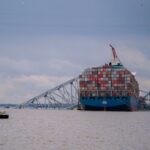According to catastrophe modeling firm AIR Worldwide, a powerful M6.6 earthquake struck off the coast of Canada’s Vancouver Island at a depth of 7.1 miles. No injuries have been reported, and there is no tsunami warning in effect, according to the National Tsunami Warning Center. Two smaller aftershocks of M5.0 and M4.2 were also reported.
AIR does not expect any significant losses from this event because this event occurred offshore and near a sparsely populated area of Victoria.
The main quake reportedly lasted about 10 seconds. In downtown Vancouver some residents in high rises said they felt their building sway. Others in homes nearer the epicenter reported swinging chandeliers. No local warnings were issued, and firefighters did not have to respond to any emergencies.
“The earthquake and its aftershocks occurred at the northern or northwestern edge of the Cascadia subduction zone where the North American Plate meets the Explorer and Juan de Fuca plates,” said Dr. Bingming Shen-Tu, assistant vice president and senior principal scientist at AIR Worldwide. “It occurred within the Nookta fault zone that borders the Juan de Fuca and Explorer plates. Seismicity near the Nootka fault zone and farther north and northwest along the Explorer/Pacific plates and North American plate boundaries has been very active in the past century. The most recent large quake was a magnitude 7.8 event that shook Haida Gwaii, about 500 km (310 miles) north of yesterday’s earthquake. There was little damage and no tsunami was generated by that quake.”
“South of the Nootka fault, tectonic forces have pushed the Juan de Fuca plate under the North American plate and created the Cascadia subduction zone. However, earthquake activity in the Cascadia subduction zone has been very quiet in the past century.”
Some scientists have speculated that for the past three centuries, these plates have been locked together, generating enormous stress within the Cascadia subduction zone. When this stress is released, powerful earthquakes can occur, such as the formidable M9.0 event that struck the region in 1700. According to geological evidence, the Cascadia subduction zone gives rise to such megathrust earthquakes every 300 to 800 years.
Dr. Shen-Tu noted, “A large megathrust earthquake within the Cascadia subduction zone would likely devastate Victoria and Vancouver in British Columbia, and seriously damage cities in the northwestern United States, including Seattle and Portland. Such an earthquake might also generate a powerful tsunami that could inundate shorelines along the west coast of North America and cause damage in countries across the Pacific Ocean, such as Japan.”
According to AIR, approximately 75 percent of residential buildings in Canada are of wood frame construction; the second most common residential structure type in Canada is masonry. In British Columbia, over 90 percent of homes are wood frame. Wood construction has historically performed well in earthquakes, due to its light weight and high material strength. Nail connections in wood frame construction allow flexibility, and thus permit wood structures to absorb large amounts of energy during earthquake shaking compared to other building types. Most commercial and industrial buildings in Canada are constructed of masonry (36%), or wood (23%); however, reinforced concrete and steel are also used. Some commercial and industrial buildings in Vancouver are made of unreinforced masonry (URM) and reinforced masonry (however, many of these buildings have been seismically retrofitted).
Source: AIR Worldwide
Was this article valuable?
Here are more articles you may enjoy.

 Synopsys Sued by Private Equity Firm for Shopping $3 Billion Unit
Synopsys Sued by Private Equity Firm for Shopping $3 Billion Unit  Property Restoration Industry: A Culture in Need of Repair?
Property Restoration Industry: A Culture in Need of Repair?  Poll: Consumers OK with AI in P/C Insurance, but Not So Much for Claims and Underwriting
Poll: Consumers OK with AI in P/C Insurance, but Not So Much for Claims and Underwriting  Bridge Disaster in Baltimore Gets FBI Criminal Investigation
Bridge Disaster in Baltimore Gets FBI Criminal Investigation 